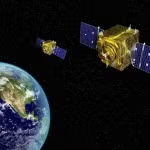
Collaboration by the National Reconnaissance Office (NRO) and the Department of the Air Force on a Space-Based Radar study continues to fulfill one of Air Force Secretary Frank Kendall's operational imperatives for the provision of ground-moving target indication (GMTI) at scale, NRO Director Chris Scolese said on Aug. 4. "There's a study that's going on that we're doing jointly that's going to inform how we move forward on that," Scolese told a Mitchell Institute for Aerospace Studies' Schriever Spacepower Forum.…














